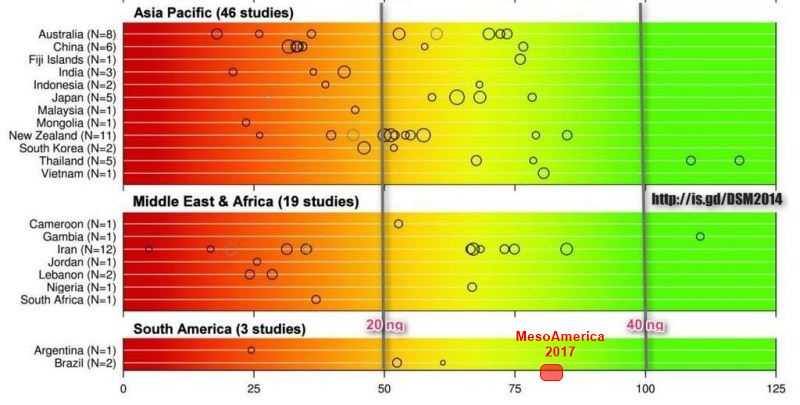Central America – 32 ng average Vitamin D level
Correlates and family aggregation of vitamin D concentrations in school-aged children and their parents in nine Mesoamerican countries.
Public Health Nutr. 2017 Jul 24:1-12. doi: 10.1017/S1368980017001616. [Epub ahead of print]
Robinson SL1, Ramirez-Zea M2, Roman AV2, Villamor E1; Nine Mesoamerican Countries Metabolic Syndrome Study (NiMeCoMeS) Group.
1 Department of Epidemiology,University of Michigan School of Public Health,1415 Washington Heights,SPH II,Room 5055,Ann Arbor,MI 48109,USA.
2 INCAP Research Center for the Prevention of Chronic Diseases,Institute of Nutrition of Central America and Panama,Guatemala City,Guatemala.

OBJECTIVE:
To determine the associations of sociodemographic characteristics, diet and outdoor activity as an indicator of sun exposure with serum 25-hydroxyvitamin D (25(OH)D) concentrations in children and their parents from Mesoamerica. We also quantified family aggregation of serum 25(OH)D.
DESIGN:
Cross-sectional study. Serum 25(OH)D concentrations were quantified using immunoassay. We compared the distribution of 25(OH)D concentrations in adults and children by levels of each correlate with the use of linear regression. Family aggregation was estimated using Pearson and intraclass correlation coefficients.
SETTING: Capital cities of Guatemala, El Salvador, the Dominican Republic, Honduras, Nicaragua, Costa Rica, Panama and Belize, and Tuxtla Gutiérrez in Mexico.
SUBJECTS: Children (n 223) aged 7-12 years and 492 parents.
RESULTS:
Mean (sd) 25(OH)D concentrations in adults and children were 81·3 (21·1) and 79·5 (18·1) nmol/l, respectively. Prevalence of vitamin D deficiency (VDD; 25(OH)D <50 nmol/l) was 3·9 % among adults and 3·6 % among children. In adults, adjusted mean 25(OH)D concentrations were highest in Nicaragua (P<0·0001). Serum 25(OH)D was positively related to time spent gardening (P=0·03). Among children, 25(OH)D concentrations were positively associated with male sex (P=0·005), dairy intake (P=0·03) and mother's serum 25(OH)D concentrations (P<0·0001); and inversely associated with mother's BMI (P=0·02) and number of home assets (P=0·04). Family membership explained 31 % of the variability in 25(OH)D concentrations; aggregation was highest between mothers and children.
CONCLUSIONS:
VDD prevalence was low in this study. Sociodemographic characteristics, diet and outdoor activity predict serum 25(OH)D. Family aggregation of serum 25(OH)D is high between mothers and children.
PMID: 28735597 DOI: 10.1017/S1368980017001616
